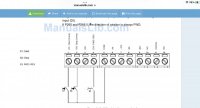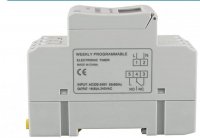Wow, I just checked the Franklin AIM manual, and those are the exact numbers they list for current when using 230 volt 3-phase 2-hp for full-load and maximum-load respectively. I just thought that was a big coincidence.
You might use a clamp-around ammeter on one phase line at a time and confirm the currents match what the controller thinks. This is not a priority, but it is simple and cheap. I have no reason to mistrust the display.
Anyway full load and maximum load currents are not what you would expect for a pump that is running out of water.
Yet I am mystified about the low 0.35 gpm flow. One thing that seems compatible with these symptoms would be a hole (or big leak) in the drop pipe. So pump pumps a lot of water, but most of it escapes. When using a pump to directly supply a house, there is a pressure tank. Then assuming there is no check valve, except at the pump, the symptom of a hole in the drop pipe would be that the pump cycles when no water is being used in the house.
But you have no pressure tank. And your pipe just exits above the cistern I expect. So what would the symptom be? I am thinking that a deeper leak would empty out the pipe of water as deep as the leak. And there would be a delay in delivering water when the pump starts. But you have a controller that may delay things for all I know, so maybe that would mask this.
A leak could also be on a long path from the well to the cistern, but you would have maybe noticed the effects of water. And maybe it is not a long path. Or maybe the leak has a path that accepts water, and you never notice anything at the surface.
Do you have a pitless adapter and a well cap up top, or more likely a well seal with pipe and wires entering into the visible top of the well seal? A pitless adapter has an o-ring, and failure there would leak water. Could there 5 gpm worth leaking out at low pressure? Seems improbable. So what test could be performed? Looking at
https://en.wikipedia.org/wiki/Prineville,_Oregon it kinda says you should have a pitless. Pitless normally means well cap, and a well cap can be lifted to observe the area around the pitless spraying water. You may hear water spraying. You may see water spraying. A bright flashlight at night or a mirror directing the sun down the well can let you see.
If you could try pressurize the entrance into the cistern, I would expect an intact path would not accept air. If you can block the entrance of water with your thumb, that would seem to make a leak shunting of the water flow likely. I am not speaking from experience.
I am not saying a big leak is probable. I am saying that it happens at times. It seems to account for your symptoms.


